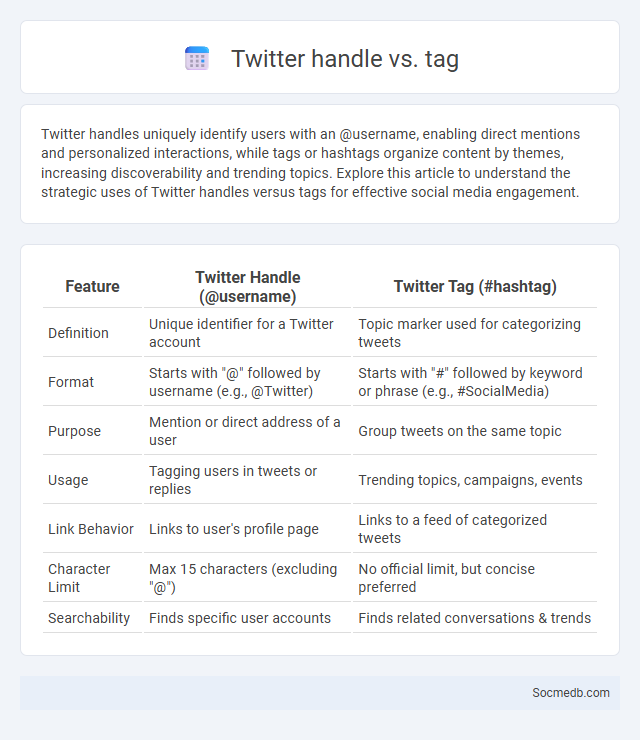
Photo illustration: Twitter Handle vs Tag
Twitter handles uniquely identify users with an @username, enabling direct mentions and personalized interactions, while tags or hashtags organize content by themes, increasing discoverability and trending topics. Explore this article to understand the strategic uses of Twitter handles versus tags for effective social media engagement.
Table of Comparison
| Feature | Twitter Handle (@username) | Twitter Tag (#hashtag) |
|---|---|---|
| Definition | Unique identifier for a Twitter account | Topic marker used for categorizing tweets |
| Format | Starts with "@" followed by username (e.g., @Twitter) | Starts with "#" followed by keyword or phrase (e.g., #SocialMedia) |
| Purpose | Mention or direct address of a user | Group tweets on the same topic |
| Usage | Tagging users in tweets or replies | Trending topics, campaigns, events |
| Link Behavior | Links to user's profile page | Links to a feed of categorized tweets |
| Character Limit | Max 15 characters (excluding "@") | No official limit, but concise preferred |
| Searchability | Finds specific user accounts | Finds related conversations & trends |
Introduction to Twitter Terminology
Twitter terminology includes key concepts such as tweets, retweets, hashtags, and mentions, which form the foundation of user interaction on the platform. Tweets are short messages limited to 280 characters, while retweets allow users to share others' content with their followers. Hashtags categorize conversations, and mentions use the "@" symbol to tag or communicate with specific users directly.
What is a Twitter Handle?
A Twitter handle is a unique username preceded by the "@" symbol that identifies a user on the Twitter platform. It enables direct communication, tagging, and brand recognition, serving as a primary digital identity for individuals, businesses, and organizations. Optimizing a Twitter handle with relevant keywords enhances visibility and engagement within Twitter's search and social networking ecosystem.
Understanding Twitter Tags
Twitter tags, commonly known as hashtags, play a crucial role in categorizing content and increasing visibility on the platform. By using relevant hashtags, users can connect with specific communities, follow trending topics, and enhance engagement rates. Effective hashtag strategies leverage popular and niche tags to maximize reach and foster targeted audience interaction.
Distinguishing Between Twitter Handle and Tag
A Twitter handle is the unique username preceded by the "@" symbol, such as @OpenAI, which identifies a specific account on the platform. A tag, or hashtag, is a keyword or phrase prefixed with the "#" symbol, like #AI, used to categorize tweets and facilitate content discovery. Understanding the difference between handles and tags is essential for effective social media engagement and targeted communication on Twitter.
The Role of Handles in Online Identity
Social media handles serve as unique identifiers that establish Your online presence and personal brand across platforms. These handles facilitate seamless connectivity, enabling others to find, follow, and engage with Your content effortlessly. Choosing a consistent and memorable handle strengthens Your digital identity and increases recognition in the crowded social media landscape.
How Twitter Tags Enhance Engagement
Twitter tags significantly boost engagement by making your content more discoverable to targeted audiences interested in specific topics or hashtags. By including relevant and trending hashtags, you increase the likelihood of your tweets being seen, shared, and interacted with, thereby expanding your reach organically. Optimizing your Twitter tags allows you to connect with niche communities, enhancing Your visibility and fostering meaningful interactions.
Common Misconceptions About Handles and Tags
Many users believe social media handles and tags function the same, but handles are unique identifiers starting with @ used for profiles, while tags connect and categorize content. You might think adding popular tags alone boosts visibility, yet relevant, niche-specific tags more effectively reach your target audience. Understanding these distinctions can enhance your engagement and improve your social media strategy.
Practical Uses of Twitter Handles
Twitter handles serve as unique identifiers that help you build a recognizable personal or brand presence on the platform. They simplify interactions by enabling direct mentions, facilitating customer support, and boosting engagement through targeted conversations. Effective use of Twitter handles can enhance your network growth, improve brand visibility, and streamline communication in real time.
Effective Strategies for Tag Usage
Effective strategies for tag usage on social media involve selecting relevant and targeted hashtags that align closely with your content and audience interests. Research popular and niche-specific tags to increase your reach while avoiding overly saturated hashtags that dilute visibility. Incorporate a mix of trending, branded, and community tags to boost engagement and help Your posts connect with the right communities.
Choosing the Right Handle and Tag for Your Brand
Selecting the right handle and tag for your brand on social media is crucial for establishing a consistent and recognizable online presence. Your handle should be unique, easy to remember, and closely aligned with your brand name to enhance discoverability and searchability. A well-crafted tag or hashtag can boost engagement, making it easier for your audience to find and share your content across platforms like Instagram, Twitter, and Facebook.
 socmedb.com
socmedb.com